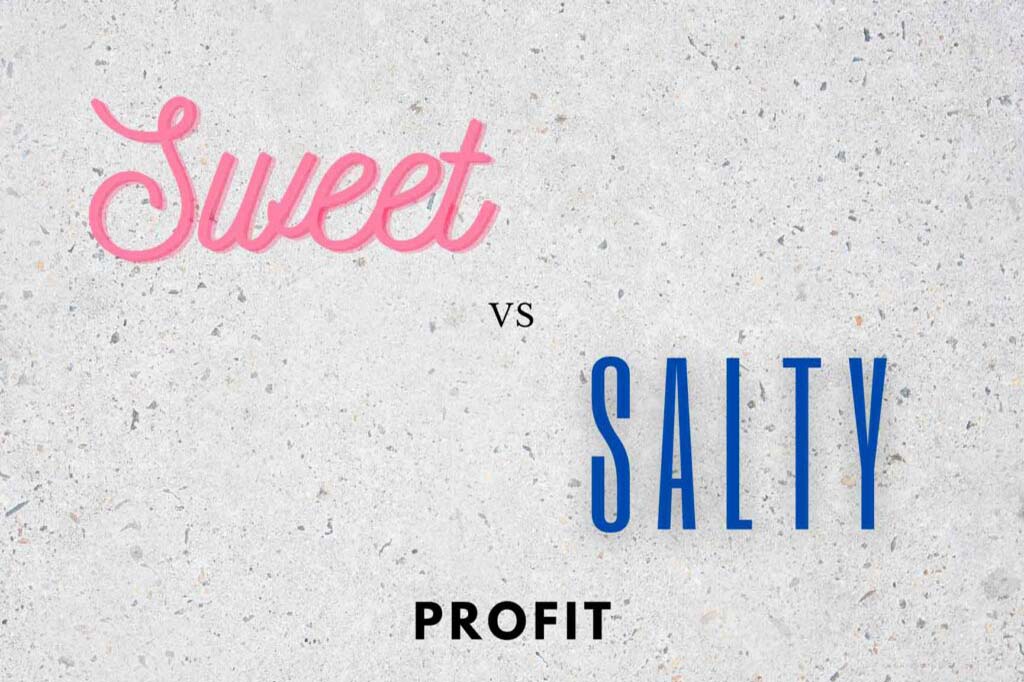“It’s only a paperclip. There’s a bunch of them in the kitchen drawer. The drawer with the batteries (dead or alive), rubber bands, crinkly bread ties, and stretch wrap. They are everywhere in that drawer. I’ll just kick this one to the side as if I never saw it. Besides just how much is one paperclip worth?”
Just how much is one worth?
More than one may imagine…
Enterprise, competition, make a profit. Billboards are found at the beginning and along the journey taken by a creative and enterprising “doer”. But the costs are high to operate an enterprise, let alone birth one.
“Discipline, discipline, discipline! Every penny counts. Because if I’m going to make this thing work, I have to guard every penny. What did Ben Franklin say again? “A penny saved is a penny earned.” Better watch those pennies.
Speaking of profit, don’t you need revenue first? Don’t you need someone to buy your “thing” first before you can save those precious pennies?
“Look Honey, I made my first profit. I believe I’ll just frame it for the wall like the hardware store owner does behind his register.”
“I know Dear (the Honey from above), exactly what did you have to do to make that entire profit?”
“Discipline, discipline, discipline…”
More than you can imagine…
Profit, that sweet sound of spendable dough, the very core of our free enterprise system.
“I love profit! I want more of it. What will I do with the dough?”
The reality, not as much as you would have hoped. You see, profit has a potential much larger than what we get to experience. “Potentially larger profit? Count me in!”
But can we count on you (question or rhetoric?)
It takes a dollar to make a dollar, huh? No, at a 10% margin, it takes nine dollars to make a dollar (profit). You see, the buyer of the thing you make may pay your price, but it takes money to make it in the first place. Raw materials, machines, facilities, taxes (Uncle Sam has open pockets), payroll (yours and theirs), benefits for those transportation, upkeep, fixing, tools, etc., forever it seems. Let’s be real; saving Ben’s penny takes effort.
Two types of profit: one is sweet and the other salty (if I may).
One takes thought, the other takes sweat. One yelps “Eureka!” the other demands, “get to work.”
Case samples:
- Cola Corp: in 2019 its revenue was $27.27 billion, but it kept just $8.62 billion profit or 23%
- BBHC (Big Box Home Center) had $110 billion in revenue but kept $11.2 billion or 10%
- Big Grocery had $123 billion in revenue but kept $16.59 billion or $13.5%
Now, what should be done with all this profit? Well, investing stockholders must get a return or they will take their money and go elsewhere. Employees (yourself included) would like a little more financial recognition. Better tools, facilities, benefits, and so on. That profit is going somewhere.
“You want more, work harder” Hold on now, last time I looked we were human and had a brain.
- Cola Corp spends .77 cents on each unit they sell for a dollar.
- BBHC spends .90 cents for each unit they then sell for a dollar
- Big Grocery spends .865 cents
If we could just trim the fat, we could make the “big money”. In today’s terms, fat would be considered as ”waste”.
There are seven (maybe eight) considerations for waste according to Tim Wood.
- Transportation-Movement of materials from one location to another.
- Inventory- raw material or finished goods costs money to make. And if it isn’t moving, it’s tying up money.
- Movement – any movement of the processor that is more than is necessary
- Waiting – Idle time waiting on something to get ready, so something can be done with it.
- Over Processing- Putting more into something than the customer is willing to pay.
- Over Production – Producing more of something than what you have orders for. “Just in case.”
- Defects – Errors that take time and effort to fix (or replace)
Every time an item is designed, the attempt is to produce it with absolutely no waste. Why wouldn’t it? So, Sales says we are going to sell this many this year. Planners say we will need this many materials to do so. Manufacturing will say we will need this type of machine, this many people, this big ole’ building to make those. Transportation will say it costs this much money to deliver. So they each build a budget to demonstrate where and why they need their portion of the investment. You’ve seen budget lines. Money for this, money for that but in no case will you see extra money for waste.
“I’m planning to waste this much money this year so give me a buck extra for each thing.”
And the Boss says, “You Mr. Jones are now fired. Nobody plans on wasting company money.”
So, everything is planned to cost this much money so we can sell it for that much. So the customer says, “Well if I can buy it for that amount, we got a deal. But I’m not paying more.”
So to make things easy, Home Depot spends 90 cents to “make” each unit of what they sell for a dollar. 10% profit. Hooray! In doing so, they plan for every action their firm is to carry out to make sales. No extra, machines, building, personnel, racks, cash registers, paper to print receipts, safety vests, asphalt for their parking lots, parking lot corrals for people to put their empty carts into, payroll, benefits, taxes, safety, quality, training, travel, on and on and on. Yes, they even plan for office necessities. Yes, that includes paper clips.
Since the customer will only pay a certain amount and refuse to pay for their supplier’s mistakes, someone has to pay for the mistakes. There’s no free lunch. The supplier (person making the error) will have to pay. Or lose the customer.
The profit planned may not be the profit realized because of those errors. “We need discipline!”
A customer that has the wrong item or a broken item sent to them isn’t going to pay for it. But they want what they ordered. So, you better make a “good” one at once and ship it to them. Remember they paid for the first go around, but not the second. Somebody has to pay for the return of the wrong (non-conforming) item, but foot the bill to ship the second.
Did you have this in your budget?
Realize that ALL costs come out of some line in the budget list. It’s not going away. If you didn’t plan for it originally, then the cost of that error will come out of the bottom line. That line where every $1 is backed by $9 of effort or investment.
Defects (non-conformance)? The paying customer won’t accept it. Extra materials are left on the production floor. Someone pays for it. Certainly not the customer. The overtime pay to fix the original defect or pay for the original inefficiencies to produce what is planned? It’s your baby. And that’s coming from somewhere. That place that carries a 9 to 1 weight on it. The profit line.
All this, and the title of this blog was “Sweet vs Salty”.
Profit is made by thought and/or action; it is engineered. Profit is value retained; thus, it mandates discipline. But what is sweet profit? It is Eureka! A better way.
Salty profit is performing what has been previously engineered and sticking to that plan. One follows the processes, checking off adherence along the way to produce the “unit” that reflects the customer’s requirements.
Sweet profit adds unit dollars without the need of spending the .90 cents to support it. It requires thought, attitude, discipline, and vision.
Salty profit makes the revenue but requires the .90 cents. It requires sweat and discipline.
Both mandate the understanding that everything a company spends money on is done so to support the profit target. That every spend is a part of the unit support. In the case of the paperclip, it would not be purchased or even allowed into the equation if someone didn’t think it would be needed.
So there is a reason for that single paperclip to exist on your desk. It was not purchased to be dropped on the floor, walked by, swept up, and thrown away. Support money was spent on it to use to build your company’s revenue product.
At 9 to 1, the value of that paper clip is multiplied by 10. The wasted excess raw materials multiplied by 10. Wasted payroll is multiplied by 10. Defective “finished” goods multiplied by 10. Return shipping, replacement shipping, inspect to verify defect, disposal costs, etc. all are multiplied by 10. Zero of their costs were figured into manufacturing budget lines, so their financial remedy: the bottom (profit) line. The very source of an employee’s pay raises enhanced benefits package, new tooling, etc.
Now, the good news, just as you can decimate your profit line, you can use the same equation to expand it. Here’s the secret… you have to think! This is the “sweet” part. When you improve what is designed (process, efficiency, materials) you expand the profit line. And you did it without spending the 90%. So, if you add a dollar profit by thinking, you are doing so without expending the .90 cents to manually create the value. For every “sweet dollar”, you save $9 of realization costs. When an individual, team, or corporation improves over the design, profit is expanded geometrically.
Safety injuries that demand support from the profit line of $1,000, will cost the company $9,000 of wasted production. The $9,000 will be used to produce enough marketable products that will be sold for $10,000 where the 10% profit will be used to pay for the injury. No injury, the $9,000 was used as designed, profiting the $1,000.
Defective “finished” or “processed” material? Every dollar used to produce or procure it must be supported by the effort to replace it. The customer still wants their order. If you can do it correctly the first time, you will be forced to do it again until you do.
Let’s say your company manufactures industrial lights. Every light is sold for $3,000. The customer orders ten. They pay the $30,000 and the cost of delivery another $2,500. When the order arrives, the lights are found with a defect that renders them unusable. The customer complains and asks that you make another ten lights. Remember, there will be no profit in the make-up order. Its allowance is not in the manufacturing budget line, so its costs come from profit. You also have to pay for the return of the original order $2,500 and reship the make-up order, another $2,500.
So, let’s put this on paper.
- At 10%, your company pays $27000 for the first round and $27000 for the makeup.
- You also have to pay for the return of $2500 and an additional $2500 to reship.
- So, your company has $59,000 invested in an order they received a $32,500 check for.
- You have lost $26,500 on this order. $26,500 that came from your bottom profit line.
- At 10 to 1, your company had to produce $265,000 worth of conforming, acceptable goods just to throw away the profit it would have produced.
- $26,500 less for raises, investment, improvement. The best way to reduce your expected and hoped-for pay raise is to screw something up. By disrespecting the value at your feet and in front of your eyes.
“Sweet profit” = money made without expenditure. Made through thought.
“Salty profit” = money made by exercising design. Made through sweat.
The next time you walk by a paperclip on the floor, don’t continue. Understand its value. That single paperclip is worth at least ten paperclips. Would you walk past ten paperclips?
PS: The 10 to 1 ratio is for companies earning 10% profit. If your company makes 5%, then every paperclip walked by is wasting 19 paperclips.



